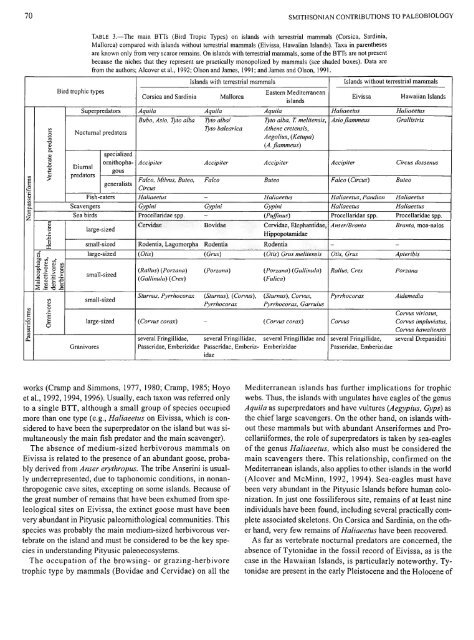PDF (Lo-Res) - Smithsonian Institution Libraries
PDF (Lo-Res) - Smithsonian Institution Libraries
PDF (Lo-Res) - Smithsonian Institution Libraries
You also want an ePaper? Increase the reach of your titles
YUMPU automatically turns print PDFs into web optimized ePapers that Google loves.
70 SMITHSONIAN CONTRIBUTIONS TO PALEOBIOLOGY<br />
Nonpasseriforms<br />
Passeriforms<br />
Vertebrate predators<br />
Herbivores<br />
Malacophages,<br />
insectivores,<br />
detritivores,<br />
herbivores<br />
Omnivores<br />
Bir d trophic types<br />
TABLE 3.—The main BTTs (Bird Tropic Types) on islands with terrestrial mammals (Corsica, Sardinia,<br />
Mallorca) compared with islands without terrestrial mammals (Eivissa, Hawaiian Islands). Taxa in parentheses<br />
are known only from very scarce remains. On islands with terrestrial mammals, some of the BTTs are not present<br />
because the niches that they represent are practically monopolized by mammals (see shaded boxes). Data are<br />
from the authors; Alcover et al., 1992; Olson and James, 1991; and James and Olson, 1991.<br />
Superpredators<br />
Nocturnal predators<br />
Diumal<br />
predators<br />
Scavengers<br />
Sea birds<br />
Granivores<br />
Fish-eaters<br />
large-sized<br />
small-sized<br />
specialized<br />
ornithophagous<br />
large-sized<br />
small-sized<br />
small-sized<br />
large-sized<br />
generalists<br />
Corsica and Sardinia<br />
Aquila<br />
Bubo, Asio, Tyto alba<br />
Accipiter<br />
Falco, Milvus, Buteo,<br />
Circus<br />
Haliaeetus<br />
Gypini<br />
Procellaridae spp.<br />
Cervidae<br />
Rodentia, Lagomorpha<br />
(Otis)<br />
(Rallus) (Porzana)<br />
(Gallinula) (Crex)<br />
Sturnus, Pyrrhocorax<br />
(Corvus corax)<br />
several Fringillidae,<br />
Passeridae, Emberizidae<br />
Islands with terrestrial mammals<br />
Aquila<br />
Mallorca<br />
Tyto alba/<br />
Tyto balearica<br />
Accipiter<br />
Falco<br />
- Gypini<br />
- Bovidae<br />
Rodentia<br />
(Grus)<br />
(Porzana)<br />
(Sturnus), (Corvus),<br />
Pyrrhocorax<br />
-<br />
several Fringillidae,<br />
Passeridae, Emberizidae<br />
works (Cramp and Simmons, 1977, 1980; Cramp, 1985; Hoyo<br />
et al., 1992, 1994, 1996). Usually, each taxon was referred only<br />
to a single BTT, although a small group of species occupied<br />
more than one type (e.g., Haliaeetus on Eivissa, which is considered<br />
to have been the superpredator on the island but was simultaneously<br />
the main fish predator and the main scavenger).<br />
The absence of medium-sized herbivorous mammals on<br />
Eivissa is related to the presence of an abundant goose, probably<br />
derived from Anser erythropus. The tribe Anserini is usually<br />
underrepresented, due to taphonomic conditions, in nonanthropogenic<br />
cave sites, excepting on some islands. Because of<br />
the great number of remains that have been exhumed from speleological<br />
sites on Eivissa, the extinct goose must have been<br />
very abundant in Pityusic paleornithological communities. This<br />
species was probably the main medium-sized herbivorous vertebrate<br />
on the island and must be considered to be the key species<br />
in understanding Pityusic paleoecosystems.<br />
The occupation of the browsing- or grazing-herbivore<br />
trophic type by mammals (Bovidae and Cervidae) on all the<br />
Eastern Mediterranean<br />
islands<br />
Aquila<br />
Tyto alba, T melitensis,<br />
Athene ere tens is,<br />
Aegolius, (Ketupa)<br />
(A. flammeus)<br />
Accipiter<br />
Buteo<br />
Haliaeetus<br />
Gypini<br />
(Puffinus)<br />
Cervidae, Elephantidae, Anser/Branta<br />
Hippopotamidae<br />
Rodentia<br />
(Otis) Grus melitensis<br />
(Porzana) (Gallinula)<br />
(Fulica)<br />
(Sturnus), Corvus,<br />
Pyrrhocorax, Garrulus<br />
(Corvus corax)<br />
several Fringillidae and<br />
Emberizidae<br />
Islands without terrestrial mammals<br />
Haliaeetus<br />
Asio flammeus<br />
Accipiter<br />
Falco (Circus)<br />
Eivissa Hawaiian Islands<br />
Haliaeetus, Pandion<br />
Haliaeetus<br />
Procellaridae spp.<br />
-<br />
Otis, Grus<br />
Rallus, Crex<br />
Pyrrhocorax<br />
Corvus<br />
several Fringillidae,<br />
Passeridae, Emberizidae<br />
Haliaeetus<br />
Grallistrix<br />
Circus dossenus<br />
Buteo<br />
Haliaeetus<br />
Haliaeetus<br />
Procellaridae spp.<br />
Branta, moa-nalos<br />
-<br />
Apteribis<br />
Porzana<br />
Aidemedia<br />
Corvus viriosus,<br />
Corvus impluviatus,<br />
Corvus hawaiiensis<br />
several Drepanidini<br />
Mediterranean islands has further implications for trophic<br />
webs. Thus, the islands with ungulates have eagles of the genus<br />
Aquila as superpredators and have vultures {Aegypius, Gyps) as<br />
the chief large scavengers. On the other hand, on islands without<br />
these mammals but with abundant Anseriformes and Procellariiformes,<br />
the role of superpredators is taken by sea-eagles<br />
of the genus Haliaeetus, which also must be considered the<br />
main scavengers there. This relationship, confirmed on the<br />
Mediterranean islands, also applies to other islands in the world<br />
(Alcover and McMinn, 1992, 1994). Sea-eagles must have<br />
been very abundant in the Pityusic Islands before human colonization.<br />
In just one fossiliferous site, remains of at least nine<br />
individuals have been found, including several practically complete<br />
associated skeletons. On Corsica and Sardinia, on the other<br />
hand, very few remains of Haliaeetus have been recovered.<br />
As far as vertebrate nocturnal predators are concerned, the<br />
absence of Tytonidae in the fossil record of Eivissa, as is the<br />
case in the Hawaiian Islands, is particularly noteworthy. Tytonidae<br />
are present in the early Pleistocene and the Holocene of

















